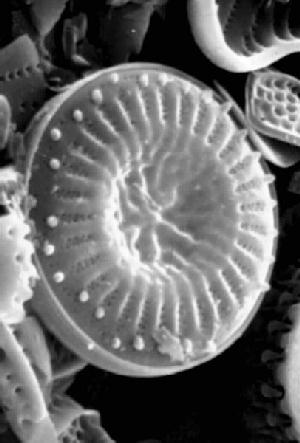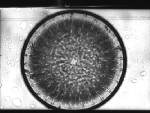Original URL: http://www.indiana.edu/%7Ediatom/diatom.html
Diatom Home Page
Biology Department, Indiana University
 Welcome to
the diatom home page, intended as a central Web resource for those interested in, or
actively conducting research on, the diatoms and related algae. This page contains
information of general interest to diatomists and other phycologists along with links to
other useful Internet resources. Most of the information is downloaded from postings to
various LISTSERVers. Please contact P. Roger
Sweets with information or links you would like to share with the community.
I welcome all contributions.
Welcome to
the diatom home page, intended as a central Web resource for those interested in, or
actively conducting research on, the diatoms and related algae. This page contains
information of general interest to diatomists and other phycologists along with links to
other useful Internet resources. Most of the information is downloaded from postings to
various LISTSERVers. Please contact P. Roger
Sweets with information or links you would like to share with the community.
I welcome all contributions.
Last updated: June 23, 1998
Contents:
Diatoms

The image above is a scanning electron micrograph (JPEG) of Cyclotella stelligera.
Diatoms are unicellular algae generally placed in the family Bacillariophyceae. The cell
walls of these organisms are made of silica, and the varied shapes and beautiful
ornamentation of these walls made the study of the diatoms and related siliceous organisms
a favored pursuit of the microscopical pioneers. The cell wall is also one of the major
reasons why these algae are today a favorite tool of modern ecological and evolutionary
researchers, because the fossils are often well preserved in lake and marine systems. And
that is, again, a small part of the story! Check the other Web sites below to learn
more!
However, sample these JPEG pictures to whet your appetite.



The Mystery Diatom
 This Mystery Diatom is growing mold,
let me know if you'd like to contribute the next one! To see a bunch of electron
micrographs (GIFs) of the now 3year old Mystery Diatom, go to the Mystery Diatom Page
This Mystery Diatom is growing mold,
let me know if you'd like to contribute the next one! To see a bunch of electron
micrographs (GIFs) of the now 3year old Mystery Diatom, go to the Mystery Diatom Page
Ultimate Diatom Web sites
Do not miss these!
Bowling Green State
University Algal Images is a Web site with lots of great images. Check it out!
The Great
Lakes Diatom Web Site from the University of Michigan. The future of diatom
reference works.
The Diatom Collection of the California
Academy of Sciences has sample locations, taxon collection, images, and a large diatom
literature database on the WWW. A 'must' stop for diatomists.
The beginning of the fight for the hearts, minds, and codes of all diatomists - DIATCODE: A coded checklist of
Diatom names (developed jointly by the ECRC and the Natural History Museum- UK).
Downloadable.
Museum Collections and Phycological Web sites
Cyanosite
: bibliography, links, images of our favorite ex-algae the Cyanobacteria
(Purdue University)
Smithsonian Institution's Algal Web
Page is online.
Travel in cyberspace to Japan's Tsukuba
University for images from many algal groups.
Excellent images and introductory material is offered by GEK, Inc. Hunt around for the video offerings of
phagocytosis and other cool stuff as well.
Dr. R. Chapman's lab at
LSU is now posting algal images on the Web.
If you're tired of the diatoms, check out Protist Image Data from
the University of Montreal.
Buckman Laboratories has
some downloadable photomicrographs of algae and other organisms.
The University of California Herbarium has a comprehensive catalogue of the Indian Ocean Benthic Algae.
Also, the all around great Berkeley museum site has a searchable catalog for
microfossil type specimens including diatoms and other protists (as well as some
images).
AND, a demonstration of the Index
Nominum Algarum and a list of Porphyra names (Richard
Moe)
Mike Guiry's Seaweed page has
much, much mre: searchable databases of literature, people, and taxonomic
names. A must link.
The Woods Hole Marine Biology group even has...Yikes!
A Cladophora Web
page!
Nothing like the Toxic
Cyanobacteria Home Page to scare the kids...
Bengt Karlsson has announced the Checklist
of phytoplankton from the Skagerrak-Kattegat (that's in the North Sea). Includes
distribution info.
Chris Jeffries has recommended his Microscopes and Microscopy site to
diatomists and phycologists browsing around.
Ed Drew's Research Shed is a fun link.
Cell biology and algal research at the Melkonian
Laboratory, Botany Institute, University of Cologne
The Provasoli-Guillard National Center for Culture of
Marine Phytoplankton offers information for those who feel the need to culture algae.
North East Pacific Culture Collection
Check out the Green
Plant Phylogeny Research Coordination Group (GPPRCG) if you would like to coordinate
with others chasing their phylogenetic dreams.
For other (non-diatom) museum holdings, see the many other great ecological home pages
listed on the paleolimnology page;
transfer to the California State BioWeb, perhaps
the best biological web server;
visit the Tree of Life;
or try the List of Internet
sites for Botanists.
Announcements
A listing of announcements as posted to the LISTSERVs
Requests and ANNOUNCEMENTS
- The Diatom Paleolimnology Data Cooperative
(DPDC)
- The NOAA Paleoclimatology Program has sponsored the creation of a diatom paleolimnology
data cooperative similar to the databases already in existence or bring formed for other
proxies such as pollen, tree rings, macrofossils, corals, etc. It is the belief of
NOAA and the DPDC creators that the cooperative will be an effective tool for
paleoecologists, paleoclimatologists, and diatomists by disseminating information,
promoting new data syntheses, planning new investigations, efficient use of data, and
archiving data in a central source, among other uses.
- This database exists and we are ready to accept the contribution of your published
data! Please visit the DPDC web page to learn more and
inform the organizers of data you can contribute!
Meetings
15th NORTH
AMERICAN DIATOM SYMPOSIUM, 22 to 25 September 1999 at the Pingree Park Campus of
Colorado State University.
- The Second European Phycological Congress (EPC 2) and the 8th International Conference
on Applied Algology
- Montecatini Terme (Italy), the EPC 2 in September 1999.
Courses
- Friday Harbor Laboratories (Washington, USA)
typically offers a course in Marine Phycology in June
- Courses on Freshwater Phycology, Limnology, and Stream Ecology also conducted every
summer (June - August) at The University of Michigan
Biological Station (Rex Lowe and Jan Stevenson)
- Courses on diatoms and other subjects are held every summer at Iowa Lakeside Lab
(Gene Stoermer)
- The Flathead Lake Biological Station of the University of
Montana hosts a Phycology Course in June (Loren Bahls)
- Algologia offers two marine phycology courses at their marine
centre at Sarti in the North Aegean Sea!
- And the University of
Manitoba Field Station at Delta Marsh, Manitoba, Canada often has a short diatom ID
course in July (Gordon Goldsborough)
- Elliot Shubert and Eileen Cox have an algae
course at Kindrogan Field Centre in the Scottish Highlands
(sounds like heaven...) in late July.
- There is a summer field course in marine botany/phycology held in June at the Shoals Marine Lab on Appledore Island, Maine, USA
(also sounds like heaven!), offered through Cornell University and the University of New
Hampshire.
Organizations & Journals
- Joining the International Diatom Society in the U.S.A.
or in Canada
- The Phycological Society of America
weighs in with their new page.
A searchable
database of recent articles is available on Mike Guiry's Seaweed page.
The Journal of Phycology (some
readable issues).
- And the British Phycological Society
has a new page as well (has issues of The Phycologist)!
- Internation Association of Limnogeology
- Protist
- The journal Phycological
Research has its own page (Japanese Phycological Society)
- North American Benthological Society
- North American Lake Management Society
- UNESCO's IOC has a Global
Directory of Marine Scientists
LISTSERVers
The DIATOM-L listserv is a forum for discussion of all matters
diatomaceous or microscopically siliceous. Subscribe at listserv@listserv.indiana.edu
Here is a list (with EMAIL addresses) of subscribers to
DIATOM-L.
View some common LISTSERV commands.
You can search an archive
of DIATOM-L.
The ALGAE-L listserv offers discussions of all things phycological.
Subscribe at LISTSERV@LISTSERV.HEA.IE or try Mike Guiry's algal WWW page.
The PSAlist is sponsored by the Phycological Society of
America. Subscribe at listserv@yuma.acns.colostate.edu
There is also a general listserver for lakes: LAKES-L.
Subscribe at MAJORDOMO@BADGER.STATE.WI.US
There is a Web page that describes the PHYCOTOXINS mailing list.
Subscribe at Lists@scotia.dfo.ca
Discussions, Literature, and Other Tidbits
From the discussion lists:
New stuff!
- Blasts from the past!
Literature and Bibliographies
Other fascinating information
Jump back to the Paleolimnology
Page
That last picture was pretty blurry so here are the same folks plus some others in the
glory days of PIRLA! Bonus, I am not in it!

The earlier pictures of me with John, Keith, & Russ; Hedy & Ed and Hannelore can still
be viewed...
Oops, almost forgot... the answer to the mystery diatom!


Last updated: June 23, 1998 URL:
http://www.indiana.edu/~diatom/diatom.html Page design and comments: P. Roger Sweets Copyright 1995, The Trustees of Indiana University
 Welcome to
the diatom home page, intended as a central Web resource for those interested in, or
actively conducting research on, the diatoms and related algae. This page contains
information of general interest to diatomists and other phycologists along with links to
other useful Internet resources. Most of the information is downloaded from postings to
various LISTSERVers. Please contact P. Roger
Sweets with information or links you would like to share with the community.
I welcome all contributions.
Welcome to
the diatom home page, intended as a central Web resource for those interested in, or
actively conducting research on, the diatoms and related algae. This page contains
information of general interest to diatomists and other phycologists along with links to
other useful Internet resources. Most of the information is downloaded from postings to
various LISTSERVers. Please contact P. Roger
Sweets with information or links you would like to share with the community.
I welcome all contributions. 



 This Mystery Diatom is growing mold,
let me know if you'd like to contribute the next one! To see a bunch of electron
micrographs (GIFs) of the now 3year old Mystery Diatom, go to the
This Mystery Diatom is growing mold,
let me know if you'd like to contribute the next one! To see a bunch of electron
micrographs (GIFs) of the now 3year old Mystery Diatom, go to the 